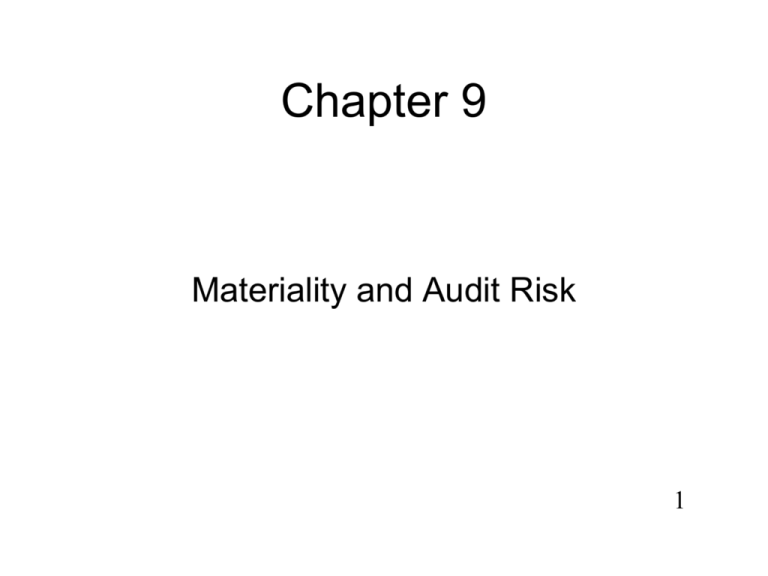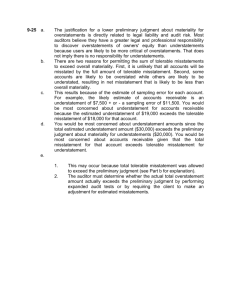ARENS 09 2158 01 Materiality and Risk
advertisement

Chapter 9 Materiality and Audit Risk 1 2 Gordon Under which auditing approach(es) are auditors required to obtain an understanding of the internal controls? 3 Katina Which section of the Auditing Standards requires auditors to obtain an understanding of the internal controls? 4 Lauren Why are auditors always required to obtain and understanding of the internal controls? 5 planning phase we are always required to obtain an understanding of the Internal Control to identify & assess the RoMM risks of material misstatement, to provide a basis for designing and implementing responses to the assessed RoMM. whether due to fraud or error, at the financial statement and relevant assertion levels through understanding the entity and its environment, including the entity's internal control, thereby 6 7 Huyen Under what audit approach(es) are auditors required to obtain sufficient appropriate audit evidence? 8 Julissa Which section of the Auditing Standards requires auditors to obtain sufficient appropriate evidence? 9 AU-C 500 Audit Evidence .04 The objective of the auditor is to design and perform audit procedures that enable the auditor to obtain sufficient appropriate audit evidence to be able to draw reasonable conclusions on which to base the auditor's opinion. 10 Marc How do we obtain audit evidence? 11 Somer What is the definition of audit risk? 12 Audit risk. The risk that the auditor expresses an inappropriate audit opinion when the financial statements are materially misstated. 13 Jena What is the definition of Materiality? 14 AU Section 312 Audit Risk and Materiality in Conducting an Audit Source: SAS No. 107. Effective for audits of financial statements for periods beginning on or after Dec. 15, 2006. Earlier application is permitted. .04 The auditor's consideration of materiality is a matter of professional judgment and is influenced by his perception of the needs of a reasonable person who will rely on the financial statements. The perceived needs of a reasonable person are recognized in the discussion of materiality in Financial Accounting Standards Board Statement of Financial Accounting Concepts No. 2, Qualitative Characteristics of Accounting Information, which defines materiality as "the magnitude of an omission or misstatement of accounting information that, in the light of surrounding circumstances, makes it probable that the judgment of a reasonable person relying on the information would have been changed or influenced by the omission or misstatement." 15 Performance Materiality Performance Materiality tolerable error tolerable misstatement The allocation of the preliminary judgment about materiality to segments (account balances or classes of transactions) 16 Xiaodan Describe a Significant Class of Transactions ? Describe a Transaction Cycle? 17 Class of Transactions Accounts receivable Sales xxx.xx xxx.xx Revenue & Collection Cycle Accounts receivable xxx.xx Sales xxx.xx Cash xxx.xx Accounts receivable xxx.xx 18 cash 250 450 350 550 200 100 375 190 330 accounts receivable 800 300 200 275 100 450 300 190 320 550 200 100 375 190 480 365 845 450 350 550 200 100 375 190 sales 550 200 100 375 190 480 365 2,260 19 Audit Risk Model 20 Nicole What are the elements of the “Audit Risk Model”? 21 Materiality and Risk the Audit Risk Model AAR = IR * CR * PDR page 128 22 Materiality and Risk the Audit Risk Model AAR = IR * CR * PDR Risk of Material Misstatement RoMM = combines IR * CR 23 Audit Risk Model AAR IR CR PDR rearrange PDR assume AAR is a constant t hen PDR AAR IR *CR c inverse relationsh ip IR*CR the planned level of PDR is a function of our assessment of CR . PDR f(CR) c. RoMM 24 Ricardo Which Component(s) of Audit Risk do you think the auditor might be able to reduce? Which Component(s) of Audit Risk do you think the auditor would be unable to reduce? 25 AAR = RoMM CR DR client auditor environmental IR balances transactions tests of details of balances substantive analytical procedures substantive tests of transactions tests of controls analytical procedures (planning) 26 Obtain engagement Understand the client AU-C 315 Analytical procedures Understand the internal controls Risk assessment Testing AU-C 500 Tests of controls (transactions) Substantive tests of transactions Substantive Analytical procedures Substantive tests of details of balances Reporting AU-C 700 27 Ian Describe the relationship between Control Risk and the planned level of Detection Risk? The mathematical relationship 28 Audit Risk Model c DR f (CR) CR we need evidence showing if CR low the controls are effective if CR high What type of audit procedures will we perform to obtain appropriate evidence that controls are effective? 29 Audit Risk Model c DR f (CR) if CR low it is OK for PDR to remain High CR if CR high PDR must be reduced to a Low level What type of audit procedures will we perform to obtain appropriate evidence to reduce Detection Risk to a low level? 30 Audit Risk Model DR f (CR) c CR if PDR high we can limit our Substantiv e Tests if PDR low we need extensive Substantiv e Tests What type of audit procedures will we perform to obtain appropriate evidence if Planned Detection Risk is high? 31 Chen What is the definition of Control Risk 32 Control risk. The risk that a misstatement that could occur in an assertion about a class of transaction, account balance, or disclosure and that could be material, either individually or when aggregated with other misstatements, will not be prevented, or detected and corrected, on a timely basis by the entity's internal control. 33 Jonathan de What is the definition of Planned Detection Risk 34 Planned Detection risk. The risk that the audit evidence for a segment will fail to detect misstatements exceeding tolerable misstatement. 35 Detection risk. The risk that the procedures performed by the auditor to reduce audit risk to an acceptably low level will not detect a misstatement that exists and that could be material, either individually or when aggregated with other misstatements. 36 Alyssa If we assess CR = Low, what does that tell us about the level of PDR …. ? If we assess CR = High, what does that tell us about the level of PDR …. ? 37 Iris If we assess CR = Max, what does that imply about the effectiveness of the Internal Controls? 38 Ciara If we assess CR = Low, what does that imply about the effectiveness of the Internal Controls? 39 Katie If we assess Control Risk as Low, what type of evidence would our audit procedures need to generate? 40 Dillon If PDR = High, what does that imply about Control Risk …. ? If PDR = Low, what does that imply about Control Risk …. ? 41 preliminary Control Risk assessment significant classes of Transactions occur complete accuracy classify cutoff Credit sales Low Cash receipts Low Low Low Low Low Low Low Low Max Low Low Low Low Low Low Low Max Low Max Low Low42 Payroll Low Cash Disburse Low Purchasing Low when we assess Control Risk less than Max Credit Sales Transactions Occur Low Complete Low Accuracy Low Classification Low Cutoff Max Control activity Test of Control Proc Results Of ToC Max Max Max 43 High Risk Areas and Transactions 44 1. Related Party Transactions 2. Non Routine Transactions 3. Judgement -Actg Estimates 4. Complex Transactions 45 1. Related Party Transactions high risk 46 Related Party Transactions high risk - page 86 & 135 One of the parties is in a position to exert significant influence over another party Related parties can structure transactions to conceal problems in the financial statements 47 2. Non Routine Transactions high risk 48 3. Judgement -Actg Estimates 49 50 Auditing accounting estimates high risk p. 135 (judgment required) Keep track of differences 51 Auditing accounting estimates With estimates, there often is no right answer • Keep track of differences between the estimate and what auditor finds reasonable • Evaluate differences taken together 52 53 4. Complex Transactions high risk page 77 - ENRON 54 Stephanie In your statistics class, why does a larger sample increase your level of confidence? How does evidence reduce risk? 55 56 Accounts Receivable Project Sample Results Tolerable Misstatement Page 125-126 1. Known misstatement $3,500 2. Projection of sample results to the population $3,500*(450,000/50,000) = $31,500 3. Allowance for sampling risk $15,750 • Estimates $47,250 – Difference between auditor’s estimate – Book Value (management’s estimate 57 58 59 60 Jon Please describe Professional Skepticism ? 61 An attitude that includes a questioning mind, being alert to conditions that may indicate possible misstatement due to fraud or error, and a critical assessment of audit evidence. 62 63 64 65 66 67 ??? Given the definition of Audit Risk what is the relationship between Materiality and Audit Risk? 68 Evaluation of Sample Results Critical Value = μ + Zβ* Sx/√n 2,295.47 + 1.04 *1,390.09 / √ 44 = 2,513.42 We are unable to conclude that Accounts Receivable is not materially overstated because the sample mean of $2,425.56 is less than the $2,513.42 critical value. 69 Sample Results Book balance size sum average 2,371,983.60 930 2,371,983.60 44 930 106,724.85 2,425.56 2,255,775.24 projected overstatement average BV sample error Projected to Population 116,208.36 2,550.52 2,425.56 124.96 Allowance for Sampling Risk = Zβ*sx/√n RIAA 15.0% Zβ std dev std error allow Projected Error plus Allowance 1.04 1,390.09 209.56 217.95 202,690.25 projected allowance 202,690.25 217.95 x930 318,898.62 342.90 318,898.62 70







